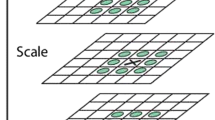Abstract
At the age of big data, the information changes quickly. How to extract the key information timely seems to be quite important. Therefore, improving the execution speed of BFS algorithm means a lot to the processing of big data. This paper firstly introduces the implementation flow, features and performance evaluation criteria of the breadth-first search algorithm, and secondly introduce the research status of BFS algorithm based on current CPU platform both at home and abroad. Thirdly, this paper optimizes the algorithm by using the local principle of program, load balancing method and so on. Finally, the comparison of the algorithm performance is shown in this paper: the program optimized in this paper gets good performance and could be popularized further in practice.









Similar content being viewed by others
References
Pan, S., Wu, J., Zhu, X., et al.: Graph ensemble boosting for imbalanced noisy graph stream classification. IEEE Trans. Cybern. 45(5), 954–968 (2015)
Chagaspaula, D.A., Oliveira, T.B., Zhang, T., et al.: Prediction of anti-inflammatory plants and discovery of their biomarkers by machine learning algorithms and metabolomic studies. Planta Med. 81(6), 450–458 (2015)
Wu, X., Yang, Z., Li, Z.H., et al.: Disease related knowledge summarization based on deep graph search. Biomed. Res. Int. 12(7), 269–272 (2015)
Corbellini, A., Mateos, C., Godoy, D., et al.: An architecture and platform for developing distributed recommendation algorithms on large-scale social networks. J. Inf. Sci. 41(5), 686–704 (2015)
Beheshtifard, Z., Meybodi, M.R.: Maximal throughput scheduling based on the physical interference model using learning automata. Ad Hoc Netw. 45(9), 65–79 (2016)
Joeris, B., Lindzey, N., Mcconnell, R.M., et al.: Simple DFS on the complement of a graph and on partially complemented digraphs. Inf. Process. Lett. 117(2), 35–39 (2017)
Chang, K.W., He, H., Iii, H.D., et al.: Learning to search for dependencies. Comput. Sci. 7(3), 96–100 (2015)
Zhai, Z., Li, S., Liu, Y.: Parameter determination of milling process using a novel teaching-learning-based optimization algorithm. Math. Probl. Eng. 9(3), 1–14 (2015)
Bellodi, E., Riguzzi, F.: Structure learning of probabilistic logic programs by searching the clause space. Theory Pract. Logic Program. 15(2), 169–212 (2015)
Author information
Authors and Affiliations
Corresponding author
Rights and permissions
About this article
Cite this article
Zhang, J., Guo, Y. & Hu, X. Research on image tagging algorithm on internet. Cluster Comput 22 (Suppl 6), 13619–13625 (2019). https://doi.org/10.1007/s10586-018-2040-3
Received:
Revised:
Accepted:
Published:
Issue Date:
DOI: https://doi.org/10.1007/s10586-018-2040-3




